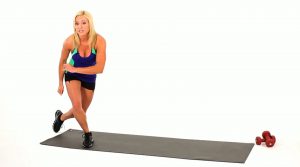It’s natural in any circumstance to become bored with your workout routine. No matter what brings boredom on, when it happens, a change is called for. We’ve talked before about the benefits of mixing it up when it comes to exercise. Doing so helps you meet your goals because it encourages your body to continue to burn fat, build muscle, or whatever you’re training for as well as keeping things interesting mentally, so you’ll be less likely to bail on exercising.

SAQ exercises are a great way to get in cardio exercise without getting bored. Image via Howcast/YouTube
The cardio part of your workout can be difficult to change satisfactorily, however. Sometimes it feels like you’ve done it all: running, biking, rowing, aerobics classes, swimming…. In the quest to keep things interesting, it’s time to HIIT the SAQ. Speed, Agility, and Quickness drills are nothing new. Soccer, basketball, and football players and many other athletes have been doing them forever. While some use special gear for their SAQ workouts, equipment is not required. You can do most of the exercises anywhere with assistance from nothing more than a clock with a second hand. That’s the only thing you’ll need to make it a High Intensity Interval Training session, so you can keep track of the time spent working out and the time spent resting between rounds. Performing SAQ as a HIIT workout delivers a double benefit: you’ll increase your fat burning capabilities plus you’ll improve your agility and speed, too.
Using SAQ for HIIT
You can turn almost any workout into High Intensity Interval Training by doing a set of exercises quickly and for time (as many reps as possible within a predetermined timeframe) and taking a short rest between exercises. So, it’s logical that you can take a set of SAQ exercises and do them in a HIIT format. The bursts of intense activity combined with short breaks are what kick up your metabolism for efficient fat burning and weight loss.
SAQ Exercises
You’ll need to familiarize yourself with exercises for speed and agility to put a workout together. Fortunately, loads of football and soccer websites such as Total Soccer Fitness and Training offer sample workouts and exercise suggestions. There are the basic, better-known training moves such as ladder drills, squat jumps, and step jacks (a walking jumping jack, forward two steps, then backward two). Add in skaters, plyo split lunges, and lateral lunges, and you have enough exercises for an effective workout.
For example, do three 30-second rounds of ladder drills with a 10 to 15-second rest between each one, then do three 30-second rounds of squat jumps, resting 10 to 15 seconds between. Continue on through each exercise, completing as many reps as possible during the 30 seconds of work. With a 45 second warm up and cool down on either side of your workout, that gives you an intense 15-minute regimen that should be easy to fit into any schedule.
When Should You SAQ?

Your body needs fuel before and after a SAQ workout, so have a light snack of carbs pre-exercise, then eat some protein afterward–eggs and turkey bacon are a great choice for an effective recovery meal.
When you do your SAQ workout is up to you, but if first thing in the morning is the only time you can exercise, don’t do it before breakfast. For the longest time, conventional training advice was that you could maximize fat burn by working out in the morning on an empty stomach. It might sound logical but, science doesn’t back that up. First off, if you’re performing HIIT workouts, you’re already enhancing after-burn–continuing to burn calories even after you’ve stopped working out. According to a study published in Sports Medicine, the type of fuel your body burns post-workout depends on what kind it burns during the workout. Basically, if you burn carbohydrates during your workout, your body will switch to burning fat afterward, and burning fat during a workout will cause your body to use carbs later on.
What’s more, you can only benefit from doing cardio on an empty stomach by going at a low intensity for an extended amount of time. How extended? A different study published in the American Journal of Physiology found that “fasted” workouts produced no difference in amounts of fat calories burned until after an hour and a half. That means you’d have to work out at a lower intensity six times longer than if you just did SAQ exercises as a HIIT workout. Bottom line, grab a light snack of carbs before your workout, then eat some protein and a few more carbs afterward. Your body will be fueled and primed to burn more calories more efficiently, and you won’t be bored with your new, quick and easy workout.
